

| TYPES OF STORMWATER FACILITIES |
Rain Gardens collect and slow stormwater run off and increase its infiltration into the soil. These attractive gardens help reduce the rapid flow of stormwater from homes and businesses to storm drains and thus protect streams and lakes from pollutants that are washed from house roofs and paved areas. GRASSED SWALES
The design of grassed swales promotes the conveyance of storm water at a slower, controlled rate and acts as a filter medium removing pollutants and allowing stormwater infiltration. When properly designed to accommodate a predetermined storm event volume, a grassed swale results in a significant improvement over the traditional drainage ditch in both slowing and cleaning of water. PERVIOUS PAVEMENT In contrast, normal pavement is an impervious surface that sheds rainfall and associated surface pollutants forcing the water to run off paved surfaces directly into nearby storm drains and then into streams and lakes. PARKING LOT FILTER STRIPS Sometimes referred to as vegetated filter strips, grassed filter strips, grassed filters or buffer strips, they help remove sediments, other pollutants and increase infiltration. Although there are few studies on effectiveness of urban filter strips in pollutant removal, properly designed and constructed, urban filter strips are thought capable of removing a minimum of 35% of solids and 40% of nutrients. Pollutant removal appears to depend on the width of the filter, a 150 feet wide strip being superior to a 75 feet wide strip.
Bioretention basins are landscaped depressions or shallow basins used to slow and treat on-site stormwater runoff. Stormwater is directed to the basin and then percolates through the system where it is treated by a number of physical, chemical and biological processes. The slowed, cleaned water is allowed to infiltrate native soils or directed to nearby stormwater drains or receiving waters. UNDERGROUND STORAGE Underground stormwater storage provides minimal stormwater quality benefits, but can be a successful segment to a development’s overall stormwater management plan, when coupled in-line with other stormwater BMPs. The addition of pretreatment features at the system’s inlet can facilitate improvements to water quality by removing floatables, skimming of oils and grease and trap some level of sediments through deposition. Pretreatment is most important if stored water is to be allowed to infiltrate into the soil, otherwise rapid clogging of the system could occur. Pretreatment features can be designed and built into the system or there are commercially available, prefabricated units that can be incorporated within the system during initial planning and design. GREEN ROOFS
Green roofs are not a new technology. Historically green roofs have been used for hundreds of years if not thousands to help keep houses in colder climes warm and houses in warmer climes cooler. In the 1960s northern Europeans began to popularize green roofs as a means of improving urban environmental quality through reduction of stormwater runoff and the addition of green space. DETENTION BASIN
A basin functions by allowing large flows of water to enter but limits the outflow by having a small opening at the lowest point of the structure. The size of this opening is determined by the capacity of underground and downstream culverts and washes to handle the release of the contained water. Frequently the inflow area is constructed to protect the structure from some types of damage. Offset concrete blocks in the entrance spillways are used to reduce the speed of entering flood water. These structures may also have debris drop vaults to collect large rocks. These vaults are deep holes under the entrance to the structure. The holes are wide enough to allow large rocks and other debris to fall into the holes before they can damage the rest of the structure. These vaults must be emptied after each storm event. RETENTION BASIN
It is distinguished from a detention basin, sometimes called a dry pond, which temporarily stores water after a storm, but eventually empties out at a controlled rate to a downstream water body. It also differs from an infiltration basin which is designed to direct stormwater to groundwaterthrough permeable soils. Wet ponds are frequently used for water quality improvement, groundwater recharge, flood protection, aesthetic improvement or any combination of these. Sometimes they act as a replacement for the natural absorption of a forest or other natural process that was lost when an area is developed. As such, these structures are designed to blend into neighborhoods and viewed as an amenity. Storm water is typically channeled to a retention basin through a system of street and/or parking lot storm drains, and a network of drain channels or underground pipes. The basins are designed to allow relatively large flows of water to enter, but discharges to receiving waters are limited by outlet structures that function only during very large storm events. Retention ponds are often landscaped with a variety of grasses, wetland plants to provide bank stability and aesthetic benefits. Vegetation also provides water quality benefits by removing soluble nutrients through uptake.[4] In some areas the ponds can attract nuisance types of wildlife like ducks or Canada Gees, particularly where there is minimal landscaping and grasses are mowed. This reduces the ability of foxes, coyotes and other predators to approach their prey unseen. Such predators tend to hide in the cattails and other tall, thick grass surrounding natural water features.
|
Copyright © 2009 Enviro-Stormwater Management
Site designed and maintained by Sonjara, Inc
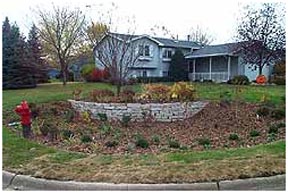 Rain Gardens are gardens containing flowering plants and grasses (preferably native species of both) that can survive in soil soaked with water from rain storms. However they are not gardens that have standing water.
Rain Gardens are gardens containing flowering plants and grasses (preferably native species of both) that can survive in soil soaked with water from rain storms. However they are not gardens that have standing water. 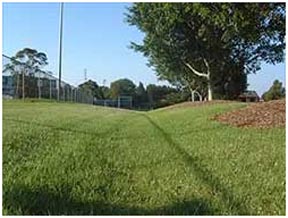 A grassed swale is a graded and engineered landscape feature appearing as a linear, shallow, open channel with trapezoidal or parabolic shape. The swale is vegetated with flood tolerant, erosion resistant plants.
A grassed swale is a graded and engineered landscape feature appearing as a linear, shallow, open channel with trapezoidal or parabolic shape. The swale is vegetated with flood tolerant, erosion resistant plants.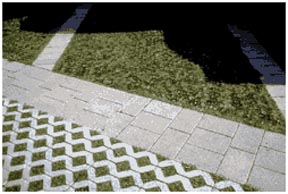 Pervious pavement is designed to allow percolation or infiltration of stormwater through the surface into the soil below where the water is naturally filtered and pollutants are removed.
Pervious pavement is designed to allow percolation or infiltration of stormwater through the surface into the soil below where the water is naturally filtered and pollutants are removed.  BIORETENTION BASINS
BIORETENTION BASINS On-site, underground stormwater retention /detention accomplishes the capture and storage of stormwater collected from surrounding impervious areas. Riser pipes or curb cuts lead surface storm water to subsurface vaults or systems of large diameter interconnected storage pipes or chambers. Stored water is then released directly through an outlet pipe back into natural waters at rates designed to reduce peak water flows during storms to mimic pre-development conditions. In some cases stored water can be allowed to
On-site, underground stormwater retention /detention accomplishes the capture and storage of stormwater collected from surrounding impervious areas. Riser pipes or curb cuts lead surface storm water to subsurface vaults or systems of large diameter interconnected storage pipes or chambers. Stored water is then released directly through an outlet pipe back into natural waters at rates designed to reduce peak water flows during storms to mimic pre-development conditions. In some cases stored water can be allowed to 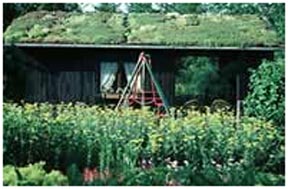 Green roofs or vegetated roof covers (also referred to as living roofs, nature roofs and eco-roofs) are a thin layer of living plants growing on top of a roof. A green roof is not a collection of potted plants to decorate a roof space but rather an extension of a conventional roof which involves instillation of a layered system of membranes, substrate and plants.
Green roofs or vegetated roof covers (also referred to as living roofs, nature roofs and eco-roofs) are a thin layer of living plants growing on top of a roof. A green roof is not a collection of potted plants to decorate a roof space but rather an extension of a conventional roof which involves instillation of a layered system of membranes, substrate and plants.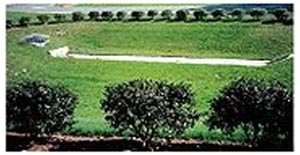 A detention
basin is an stormwater management facility installed on, or adjacent to, tributaries of rivers, streams,
lakes or bays that is designed to protect against flooding and, in some cases, downstream erosion by storing water for a limited period of a time. These basins are also called "dry ponds", "holding ponds" or "dry detention basins" if no permanent pool of water exists. Some detention ponds are also "wet ponds" in that they are designed to permanently retain some volume of water at all times. In its basic form a detention basin is used to manage water quantity while having a limited effectiveness
in protecting water quality, unless it includes a permanent pool feature.[1]Detention basins are storm water
best management practices (BMPs) that provide general flood protection and can also control extreme floods such as a 1
in 100-year storm event.[2] The basins are typically built during the construction of new land development projects
including residential subdivisions or shopping centers. The ponds help manage the excess runoff generated by
newly-constructed impervious surfaces such as roads, parking lots and rooftops.
A detention
basin is an stormwater management facility installed on, or adjacent to, tributaries of rivers, streams,
lakes or bays that is designed to protect against flooding and, in some cases, downstream erosion by storing water for a limited period of a time. These basins are also called "dry ponds", "holding ponds" or "dry detention basins" if no permanent pool of water exists. Some detention ponds are also "wet ponds" in that they are designed to permanently retain some volume of water at all times. In its basic form a detention basin is used to manage water quantity while having a limited effectiveness
in protecting water quality, unless it includes a permanent pool feature.[1]Detention basins are storm water
best management practices (BMPs) that provide general flood protection and can also control extreme floods such as a 1
in 100-year storm event.[2] The basins are typically built during the construction of new land development projects
including residential subdivisions or shopping centers. The ponds help manage the excess runoff generated by
newly-constructed impervious surfaces such as roads, parking lots and rooftops.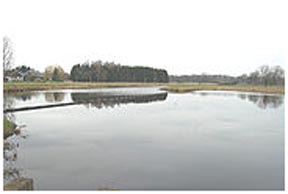 A retention basin, is a type of best management practice (BMP) that is used to manage stormwater runoff to prevent flooding and
downstream erosion, and improve water quality in an adjacent river, stream, lake or bay. Sometimes called a wet pond or wet detention basin, it is essentially an artificial lake
with vegetation around the perimeter, and includes a permanent pool of water in its design.
A retention basin, is a type of best management practice (BMP) that is used to manage stormwater runoff to prevent flooding and
downstream erosion, and improve water quality in an adjacent river, stream, lake or bay. Sometimes called a wet pond or wet detention basin, it is essentially an artificial lake
with vegetation around the perimeter, and includes a permanent pool of water in its design.